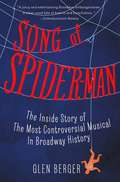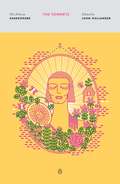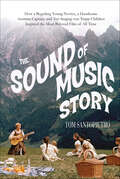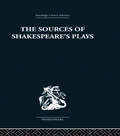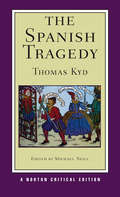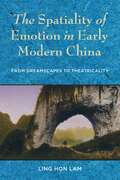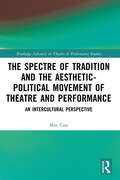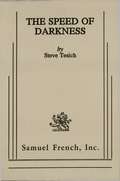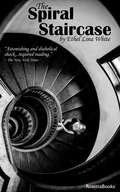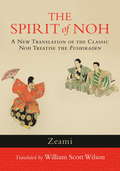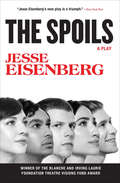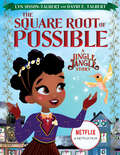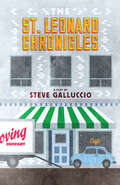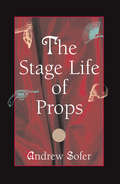- Table View
- List View
The Smart Words and Wicked Wit of William Shakespeare
by Max Morris“Better a witty fool, than a foolish wit,” said the world’s greatest and most preeminent English writer of all time, William Shakespeare.Have you ever wanted to quote the most quoted writer in the English language? Deliver the most inventive and debasing Shakespearean insult (“Would thou wert clean enough to spit upon!”)? Recite titillating love poetry like a modern-day Romeo to his (or her) Juliet? Or commit a learned wisdom about life’s woes to memory? The Smart Words and Wicked Wit of William Shakespeare is the perfect pocket book to carry around in your arsenal. Laugh, cry, rage, and muse along with beloved (or not so beloved) Shakespeare characters like Hamlet, Lady Macbeth, King Lear, and Cleopatra on the topics of love, art, beauty—as well as life’s most irreverently relevant insights. Full of savvy wisdoms from works such as Twelfth Night, Othello, A Midsummer Night’s Dream, As You Like It, and many others, this inspiring collection compiles the wisest and wittiest Shakespearean quotations that speak of the writer’s enduring legacy—even in contemporary pop culture.
The Song of Spider-Man
by Glen BergerFrom the show's cowriter who saw it all firsthand, this is the epic story of the most expensive, ambitious, dangerous, and controversial Broadway musical of all-time: Spider-Man.Never in the history of Broadway has there been anything like Spider-Man: Turn Off the Dark. Lampooned by reviewers, loved and loathed by audiences, and boldly envisioned by its producers, Spider-Man has forever made its mark in pop culture history. Author Glen Berger was present at the creation, when visionary director Julie Taymor selected him to collaborate with her on the book of the musical. For seven years, Berger was an eyewitness to great artistic hopes and battles as Taymor sought to bring her vision to the stage, along with celebrated rock stars Bono and the Edge. But despite terrible reviews and public ridicule, Spider-Man went on to become one of the top ten grossing musicals in the history of Broadway--a feat inseparable from its creators' unassailable passion, immense efforts, and artistic ambition. With a sharp eye for detail and candid sense of humor, Berger reveals every aspect--the highs and lows--of the production and in doing so, takes us inside the theatrical process in a way few authors can. The Song of Spider-Man is the ultimate fly-on-the-wall account of how Broadway works, how big musicals are made, and how great artists continue to dream, even in the midst of a nightmare.
The Sonnets
by William Shakespeare John Hollander Stephen Orgel A. R. BraunmullerTogether with A Lover's Complaint' and little-known alternative versions of four of the sonnets. Edited with an introduction by Stanley Wells. ...the most beautifully printed text available.'
The Sopranos (TV Milestones)
by Gary EdgertonFrom its premiere in 1999, The Sopranos captivated viewers with its easily relatable protagonist who has troubles at work and home, and went on to be one of the most critically successful shows in television history. By demonstrating that TV could be at once artistic and profitable, complex and engaging, edifying and entertaining, the series also redefined the prime-time drama. In this volume, author Gary R. Edgerton delves into the entire run of The Sopranos, integrating the existing scholarly literature, while also going much further than any previous source in exploring the series' innovations and legacy. First, Edgerton describes and analyzes The Sopranos' enormous business and industrial significance within the context of HBO as a network, a diversified entertainment company, and an identity brand. In chapter 2, he examines the many autobiographical influences and work experiences of creator David Chase and the narrative antecedents that informed the series' beginnings. In chapter 3, Edgerton underscores The Sopranos' deeply evocative sense of place, honing in especially on the cultural geography of New Jersey as representative of the nation as a whole. Finally, in chapter 4, Edgerton highlights how The Sopranos marks "A Midlife Crisis for the Gangster Genre" by illustrating some of the most profound generic transformations that took place over the course of the show, while his conclusion summarizes The Sopranos' ongoing industrial, aesthetic, and cultural legacy. The Sopranos is widely recognized in both popular and scholarly literature as a turning point in the history and development of TV. Fans who want to learn more about the show and scholars of television history will enjoy this entertaining and educational volume.
The Soul of Pleasure: Sentiment and Sensation in Nineteenth-Century American Mass Entertainment
by David MonodShow business is today so essential to American culture it's hard to imagine a time when it was marginal. But as David Monod demonstrates, the appetite for amusements outside the home was not "natural": it developed slowly over the course of the nineteenth century. The Soul of Pleasure offers a new interpretation of how the taste for entertainment was cultivated. Monod focuses on the shifting connection between the people who built successful popular entertainments and the public who consumed them. Show people discovered that they had to adapt entertainment to the moral outlook of Americans, which they did by appealing to sentiment.The Soul of Pleasure explores several controversial forms of popular culture—minstrel acts, burlesques, and saloon variety shows—and places them in the context of changing values and perceptions. Far from challenging respectability, Monod argues that entertainments reflected and transformed the audience’s ideals. In the mid-nineteenth century, sentimentality not only infused performance styles and the content of shows but also altered the expectations of the theatergoing public. Sentimental entertainment depended on sensational effects that produced surprise, horror, and even gales of laughter. After the Civil War the sensational charge became more important than the sentimental bond, and new forms of entertainment gained in popularity and provided the foundations for vaudeville, America’s first mass entertainment. Ultimately, it was American entertainment’s variety that would provide the true soul of pleasure.
The Sound of Music Story: How a Beguiling Young Novice, a Handsome Austrian Captain, and Ten Singing von Trapp Children Inspired the Most Beloved Film of All Time
by Tom Santopietro&“Fans of The Sound of Music will find plenty to please them in [this] history of the sweeping musical.&” —Kirkus Reviews On March 2, 1965, The Sound of Music was released in the United States and the love affair between moviegoers and the classic Rodgers and Hammerstein musical began. Rarely has a film captured the love and imagination of the moviegoing public the way The Sound of Music did as it blended history, music, stunning Austrian locations, heartfelt emotion—and the yodeling of Julie Andrews—into a monster hit. Now, Tom Santopietro has written the ultimate book for fans with behind the scenes stories of the filming, new interviews with Johannes von Trapp and others, photographs, and more. He looks back at the real life story of Maria von Trapp, goes on to chronicle the sensational success of the Broadway musical, and recounts the near cancellation of the film when Cleopatra bankrupted 20th Century Fox. He reveals the actors who were also considered for the roles of Maria and Captain von Trapp, and provides a historian&’s critical analysis of the careers of director Robert Wise and screenwriter Ernest Lehman. He also takes a look at the critical controversy that greeted the movie, its relationship to the turbulent 1960s, and the superstardom that engulfed Julie Andrews. The Sound of Music Story is for everyone who cherishes this American classic.
The Sound of Shakespeare (Accents on Shakespeare)
by Wes FolkerthThe 'Sound of Shakespeare' reveals the surprising extent to which Shakespeare's art is informed by the various attitudes, beliefs, practices and discourses that pertained to sound and hearing in his culture. In this engaging study, Wes Folkerth develops listening as a critical practice, attending to the ways in which Shakespeare's plays express their author's awareness of early modern associations between sound and particular forms of ethical and aesthetic experience. Through readings of the acoustic representation of deep subjectivity in Richard III, of the 'public ear' in Antony and Cleopatra, the receptive ear in Coriolanus, the grotesque ear in A Midsummer Night's Dream, the 'greedy ear' in Othello, and the 'willing ear' in Measure for Measure, Folkerth demonstrates that by listening to Shakespeare himself listening, we derive a fuller understanding of why his works continue to resonate so strongly with is today.
The Sources of Shakespeare's Plays
by Kenneth MuirFirst published in 1977. This book ascertains what sources Shakespeare used for the plots of his plays and discusses the use he made of them; and secondly illustrates how his general reading is woven into the texture of his work. Few Elizabethan dramatists took such pains as Shakespeare in the collection of source-material. Frequently the sources were apparently incompatible, but Shakespeare's ability to combine a chronicle play, one or two prose chronicles, two poems and a pastoral romance without any sense of incongruity, was masterly. The plays are examined in approximately chronological order and Shakespeare's developing skill becomes evident.
The Soviet Theater
by Mr Laurence Senelick Mr Sergei OstrovskyIn this monumental work, Laurence Senelick and Sergei Ostrovsky offer a panoramic history of Soviet theater from the Bolshevik Revolution to the eventual collapse of the USSR. Making use of more than eighty years' worth of archival documentation, the authors celebrate in words and pictures a vital, living art form that remained innovative and exciting, growing, adapting, and flourishing despite harsh, often illogical pressures inflicted upon its creators by a totalitarian government. It is the first comprehensive analysis of the subject ever to be published in the English language.
The Spaces of Irish Drama
by Helen Heusner LojekLojek provides extensive analysis of space in plays by living Irish playwrights, applying practical understandings of staging and the insights of geographers and spatial theorists to drama in an era increasingly aware of space.
The Spamalot Diaries
by Eric Idle&“A rollicking account of the making of [the] Broadway musical Spamalot [and] an irresistible and unfiltered ode to the art of live theater. Fans will love this tantalizing glimpse behind the curtain.&”—Publishers Weekly (starred review)From comedy legend Eric Idle, the fascinating inside story of bringing Monty Python and the Holy Grail to Broadway as the unlikely theatrical hit Spamalot On March 17, 2005, Spamalot debuted on Broadway to rapturous reviews for its star-studded creative team, including creators Eric Idle and John du Prez, director Mike Nichols, and stars Hank Azaria, David Hyde Pierce, Sara Ramirez, Tim Curry, and more. But long before the show was the toast of Broadway and the winner of three Tony Awards, it was an idea threatening to fizzle out before it could find its way into existence. Now, in The Spamalot Diaries, Eric Idle shares original journal entries and raw email exchanges—all featuring his whip-smart wit—that reveal the sometimes bumpy, always entertaining path to the show&’s unforgettable run. In the months leading up to that opening night, financial anxieties were high with a low-ceiling budget and expectations that it would take two years to break even. Collaborative disputes put decades-long friendships to the test. And the endless process of rewriting was a task as passionate as it was painstaking. Still, there&’s nothing Idle would change about that year. Except for the broken ankle. He could do without the broken ankle. Chronicling every minor mishap and triumph along the way, as well as the creative tension that drove the show to new heights, The Spamalot Diaries is an unforgettable look behind the curtain of a beloved musical and inside the wickedly entertaining mind of one of our most treasured comic performers.
The Spanish Tragedy
by Thomas KydThe freshly edited and annotated text comes with a full introduction and illustrative materials intended for student readers. The Spanish Tragedy was well known to sixteenth-century audiences, and its central elements--a play-within-a-play and a ghost bent on revenge--are widely believed to have influenced Shakespeare's Hamlet. This volume includes a generous selection of supporting materials, among them Kyd's likely sources (Virgil, Jacques Yver, and the anonymous "The Earl of Leicester Betrays His Own Servant"), Thomas Nashe's satiric criticism of Kyd, Michel de Montaigne and Francis Bacon on revenge, and "The Ballad of The Spanish Tragedy," which suggests the play's initial reception. "Criticism" is thematically organized to provide readers with a clear sense of the play's major themes. Contributors include Michael Hattaway, Jonas A. Barish, Donna B. Hamilton, G. K. Hunter, Lorna Hutson, Molly Smith, J. R. Mulryne, T. McAlindon, and Andrew Sofer. A Selected Bibliography is also included.
The Spatiality of Emotion in Early Modern China: From Dreamscapes to Theatricality
by Ling Hon LamEmotion takes place. Rather than an interior state of mind in response to the outside world, emotion per se is spatial, at turns embedding us from without, transporting us somewhere else, or putting us ahead of ourselves. In this book, Ling Hon Lam gives a deeply original account of the history of emotions in Chinese literature and culture centered on the idea of emotion as space, which the Chinese call “emotion-realm” (qingjing).Lam traces how the emotion-realm underwent significant transformations from the dreamscape to theatricality in sixteenth- to eighteenth-century China. Whereas medieval dreamscapes delivered the subject into one illusory mood after another, early modern theatricality turned the dreamer into a spectator who is no longer falling through endless oneiric layers but pausing in front of the dream. Through the lens of this genealogy of emotion-realms, Lam remaps the Chinese histories of morals, theater, and knowledge production, which converge at the emergence of sympathy, redefined as the dissonance among the dimensions of the emotion-realm pertaining to theatricality.The book challenges the conventional reading of Chinese literature as premised on interior subjectivity, examines historical changes in the spatial logic of performance through media and theater archaeologies, and ultimately uncovers the different trajectories that brought China and the West to the convergence point of theatricality marked by self-deception and mutual misreading. A major rethinking of key terms in Chinese culture from a comparative perspective, The Spatiality of Emotion in Early Modern China develops a new critical vocabulary to conceptualize history and existence.
The Spectre of Tradition and the Aesthetic-Political Movement of Theatre and Performance: An Intercultural Perspective (Routledge Advances in Theatre & Performance Studies)
by Min TianThis book interrogates anew the phenomenon of tradition in a dialogical debate with a host of Western thinkers and critical minds. In contrast to the predominantly Western approaches, which look at traditions (Western and non-Western) from a predominantly (Western) modernist perspective, this book interrogates, from an intercultural perspective, the transnational and transcultural consecration, translation, (re)invention, and displacement of traditions (theatrical and cultural) in the aesthetic-political movement of twentieth-century theatre and performance, as exemplified in the case studies of this book. It looks at the question of traditions and modernities at the centre of this aesthetic-political space, as modernities interculturally evoke and are haunted by traditions, and as traditions are interculturally refracted, reconstituted, refunctioned, and reinvented. It also looks at the applicability of its intercultural perspective on tradition to the historical avant-garde in general, postmodern, postcolonial, and postdramatic theatre and performance and to the twentieth-century "classical" intercultural theatre and the twenty-first-century "new interculturalisms" in theatre and performance. To conclude, it looks at the future of tradition in the ecology of our globalized theatrum mundi and considers two important interrelated concepts, future tradition and intercultural tradition. This book will be of great interest to students and scholars in performance studies.
The Speed of Darkness
by Steve TesichDrama / 3m, 2f / Interiors / Len Cariou and Stephen Lang starred on Broadway in this history making play as Joe, a successful businessman and pillar of society whose chickens come home to roost in the form of Lou, a deranged Vietnam War buddy. During their confrontation, Joe learns that his daughter is not his daughter and the terrible secret of his past is exposed: his climb up the ladder of success began when he and Lou illegally dumped barrels and barrels of toxic waste over the bluff above town, poisoning the water supply. Lou kills himself, leaving Joe and his family to face the consequences of irresponsibility.
The Spelling Bee
by Marsha SheinessBlack Comedy \ 4 m., 4 f. \ 1 int. \ A taut, suspenseful comedy that builds to a shocking climax as four children written to be played by adults compete in the televised National Championship runoffs for the best speller in the country. Each mother is determined that her child will win, while the Quizzer intends the show to be a springboard into the "big time." \ "A pleasure.... Discipline, tightly written.... Scores those who will use any means to achieve a success of the moment." N.Y. Daily News.
The Spiral Staircase
by Ethel White"Adept at laying one icy finger on the back of your neck" - SpectatorHelen Capel is hired as a live-in lady-help to the Warren family in the countryside. She enjoys the eccentric household and her duties, but her peaceful and simple life is soon disturbed by a series of mysterious murders in the isolated community.As Helen's employer, Professor Sebastian Warren, battens down the hatches and locks all the doors of their remote country house, the eight residents begin to feel safe. But somewhere out there lurks a murderer of young girls. As the murders crawl closer to home, Helen starts to wonder if there really is safety in numbers--and what happens when those numbers start to dwindle?
The Spirit of Noh: A New Translation of the Classic Noh Treatise the Fushikaden
by Zeami William Scott WilsonThe Japanese dramatic art of Noh has a rich six-hundred-year history and has had a huge influence on Japanese culture and such Western artists as Ezra Pound and The Japanese dramatic art of Noh has long held a fascination for people both in the East and the West. For six hundred years it has had a huge influence on Japanese culture--and has inspired such Western artists as Ezra Pound and William Butler Yeats. Here is a translation of the Fushikaden, a seminal treatise on Noh by the fifteenth-century actor and playwright Zeami (1363-1443), the most celebrated figure in the art's history. His writings on Noh were originally secret teachings that were later coveted among the highest ranks of the samurai class and first became available to the general public only in the twentieth century. The Fushikaden is the best known of Zeami's writings on Noh and it provides practical instruction for actors, gives valuable teachings on the aesthetics and spiritual culture of Japan, and offers a philosophical outlook on life. Along with the Fushikaden, translator William Scott Wilson includes a comprehensive introduction describing the intriguing history behind this enigmatic and influential art form, and also a new translation of one of Zeami's most moving plays, Atsumori.
The Spoils: A Play (Books That Changed the World)
by Jesse EisenbergA powerful play about wealth, narcissism, and entitlement: “Eisenberg writes funny, but he is also a real storyteller—moody and dangerous and even loving.”—NewsdayNobody likes Ben. Ben doesn’t even like Ben. He’s been kicked out of grad school, lives off his parents’ money, and bullies everyone in his life, including his roommate, an earnest Nepalese immigrant. When Ben discovers that his grade school crush is marrying a straitlaced banker, he sets out to destroy their relationship and win her back. The Spoils is a deeply personal and probing comedy written by Jesse Eisenberg—Academy Award-nominated actor, playwright, and contributor to the New Yorker. “While Ben would surely say The Spoils is all about Ben, Mr. Eisenberg has seen fit to surround his leading narcissist with characters who live and breathe and react independently…His clever, frantic dialogue assumes an irresistible authenticity.”—Ben Brantley, The New York Times (NYT Critics’ Pick)
The Square Root of Possible: A Jingle Jangle Story
by David E. Talbert Lyn Sisson-TalbertA charming picture book story based on the Netflix holiday film Jingle Jangle, starring Phylicia Rashad, Forrest Whitaker, Anika Noni Rose, Keegan Michael Key, and newcomer Madalen Mills, about an eccentric toymaker, his adventurous granddaughter, and a magical invention, that if they can get it to work in time for the holidays, could change their lives forever.A heartwarming picture book story based on the song "The Square Root of Possible" from the Netflix holiday film Jingle Jangle: A Christmas Journey! A holiday tale set in the snow-covered town of Cobbleton, Jingle Jangle follows eccentric toymaker Jeronicus Jangle (Academy Award winner Forest Whitaker) whose fanciful inventions burst with whimsy and wonder. But when a betrayal by a former protégé (Keegan-Michael Key) leaves Jeronicus withdrawn and down on his luck, it's up to his bright and adventurous granddaughter, Journey (newcomer Madalen Mills) -- and a singularly magical invention -- to save the day. From the imagination of writer/director David E. Talbert and featuring original music by John Legend, Philip Lawrence, and Davy Nathan, Jingle Jangle reminds you that anything is possible...if you believe.
The St. Leonard Chronicles
by Steve GalluccioFrom the award-winning author of stage hits Mambo Italiano and In Piazza San Domenico comes a delicious, saucy new comedy about Terry and Robert, a young couple with roots in the Italian neighbourhood of St. Leonard in Montreal. The couple's newly renovated duplex has barely a hint of gilded rococo - not just a cultural infraction, but also an ominous sign that all is not as it should be. Eager to break free of family ties that are bound too tight, Terry and Robert announce they're moving to the affluent anglophone suburb of Beaconsfield - tantamount to committing a mortal sin in the eyes of their more traditional Italian relatives. When they confess their plans to their parents over dinner one night, floodgates open to other unspoken desires and revelations, turning conservative St. Leonard values upside down.The St. Leonard Chronicles opened the 2013-14 season at Montreal's venerable Centaur Theatre and sold out before its run. The play was extended and went on to sell more than twenty thousand tickets. The French version of the Chronicles, translated by Galluccio himself, premieres at Theâtre Jean Duceppe in Montreal in December 2014 and then in 2015 embarks on a twenty-four-city tour.Cast of 4 women and 3 men.
The Stage Director’s Prompt Book: A Guide to Creating and Using the Stage Director’s Most Powerful Rehearsal and Production Tool
by Leslie FerreiraThe Stage Director’s Prompt Book is a step-by-step, detailed guide on how to create a practical and powerful rehearsal and performance tool—the director’s prompt book. A prompt book is a coordinating and organizational tool for the stage director. This book systematizes the creative process the director uses to analyze and interpret a play and coordinates all director-related rehearsal and production activities into a single, self-contained interpretive and organizational system. This book guides the director through the necessary steps and stages of creating and using a prompt book—from play analysis and interpretation, through the formation of a dynamic and theatrical director’s vision, to a unique method of physicalizing a play in production. A prompt book of a one-act play is included in the book as a complete example of the system. Such techniques as redlining, color coding and creating a three-column left-hand page are vividly illustrated for readers, allowing them to assemble their own prompt books. In a clear and example-driven format, The Stage Director’s Prompt Book offers a system of directorial interpretation that takes the director through a series of point-by point instructions to construct a strong, effective and creative instrument for success. For the undergraduate and graduate student of theatre directing, stage management and producing courses, along with aspiring professional directors, this book provides an interactive and intuitive approach to personalize the stage directing experience and assemble a graphically dynamic and creative director’s prompt book.
The Stage Life of Props
by Andrew SoferInThe Stage Life of Props,Andrew Sofer aims to restore to certain props the performance dimensions that literary critics are trained not to see, then to show that these props are not just accessories, but time machines of the theater. Using case studies that explore the Eucharistic wafer on the medieval stage, the bloody handkerchief on the Elizabethan stage, the skull on the Jacobean stage, the fan on the Restoration and early eighteenth-century stage, and the gun on the modern stage, Andrew Sofer reveals how stage props repeatedly thwart dramatic convention and reinvigorate theatrical practice. While the focus is on specific objects, Sofer also gives us a sweeping history of half a millennium of stage history as seen through the device of the prop, revealing that as material ghosts, stage props are a way for playwrights to animate stage action, question theatrical practice, and revitalize dramatic form. Andrew Sofer is Assistant Professor of English, Boston College. He was previously a stage director.
The Stage Management Handbook
by Daniel A. IonazziA complete examination of the stage manager's job, explaining the manager's involvement with all aspects of theater work including interfacing with the playwright, director, producer and designer.
The Stage Management Handbook
by Daniel A. IonazziThe stage manager is the renaissance man of the theater. He or she must have a working knowledge of how the various technical aspects of the theater work (scenery, props, costumes, lights and sound), be part director, part playwright, part designer and part producer, and be prepared to act as confidant, counselor and confessor to everyone else in the company. This book addresses all of these considerations in detail and offers the reader–professional or amateur, veteran or beginner–helpful guidance and practical advice, supported by many forms and examples to illustrate the points covered in the text. The three phrases of mounting and performing a show are covered. Part I takes the reader through the pre-production phase–research, the script, planning and organization, and auditions. Part II covers the rehearsal process–rehearsal rules, blocking, cues, prompting, information distribution, technical and dress rehearsals. Part III discusses the performance phase–calling the show, maintaining the director's work, working with understudies and replacements, and more. Part IV provides insights into the organizational structure or some theaters and aspects of human behavior in those organizations. Many stage managers of long-running commercial productions believe that–once the show is up and running–only ten percent of their work is related to everything covered in Parts I, II and III. The other ninety percent is associated with issues in Part IV; i.e. "managing" human behavior and maintaining working relationships.

